Spatio-Temporal Impacts of Biofuel Production and Climate Variability on Water Quantity and Quality in Upper Mississippi River Basin
Abstract
:1. Introduction
- (1)
- Where is water availability likely to be a limiting factor?
- (2)
- How will extreme events affect crop yields and water availability and quality?
- (3)
- What are the possible water quality effects associated with increases in production of different kinds of biomass?
- (4)
- What agricultural practices might help reduce water use or minimize water pollution associated with biomass production?
2. Materials and Methods
2.1. Study Area
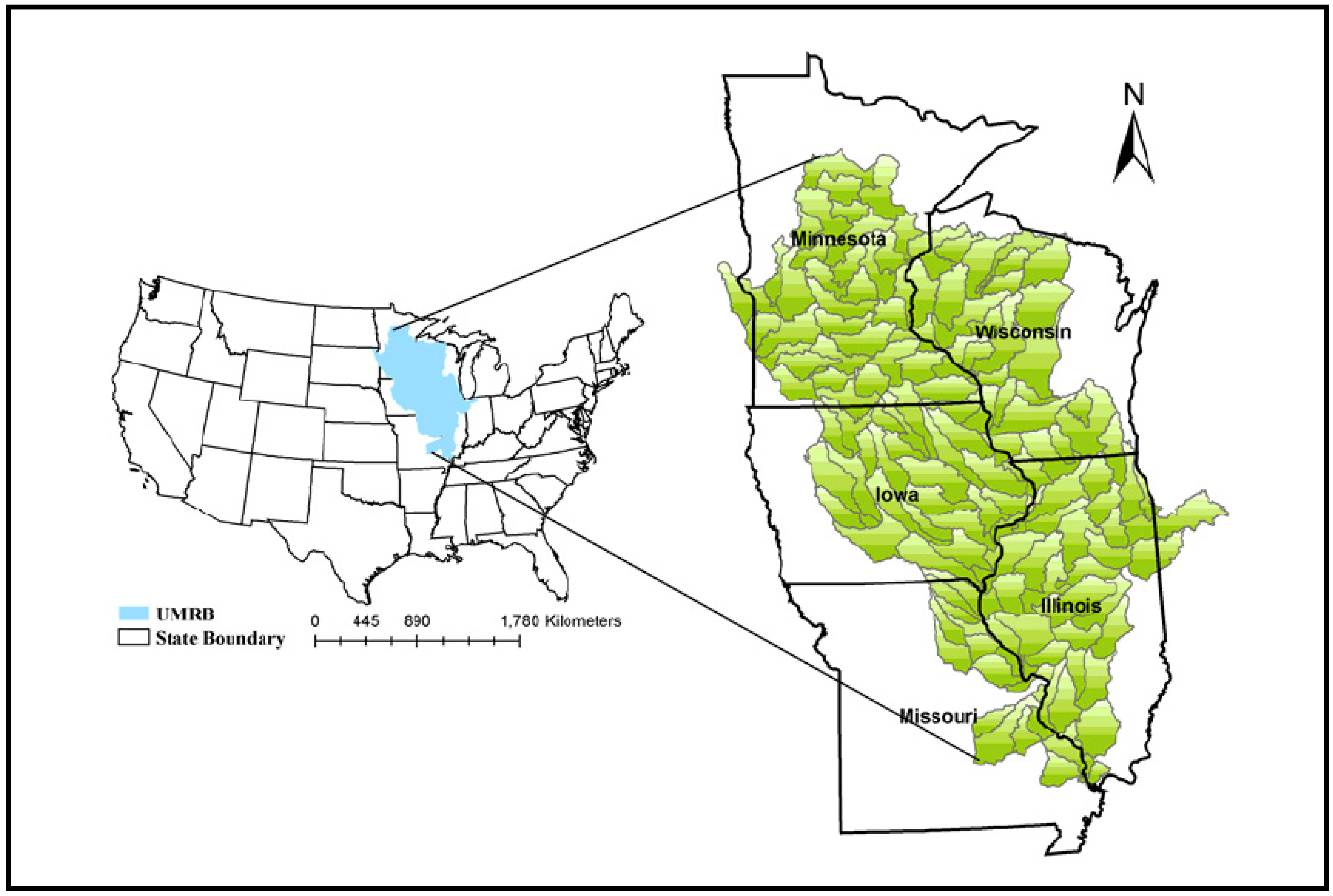
2.2. Model Description
2.3. UMRB SWAT Model
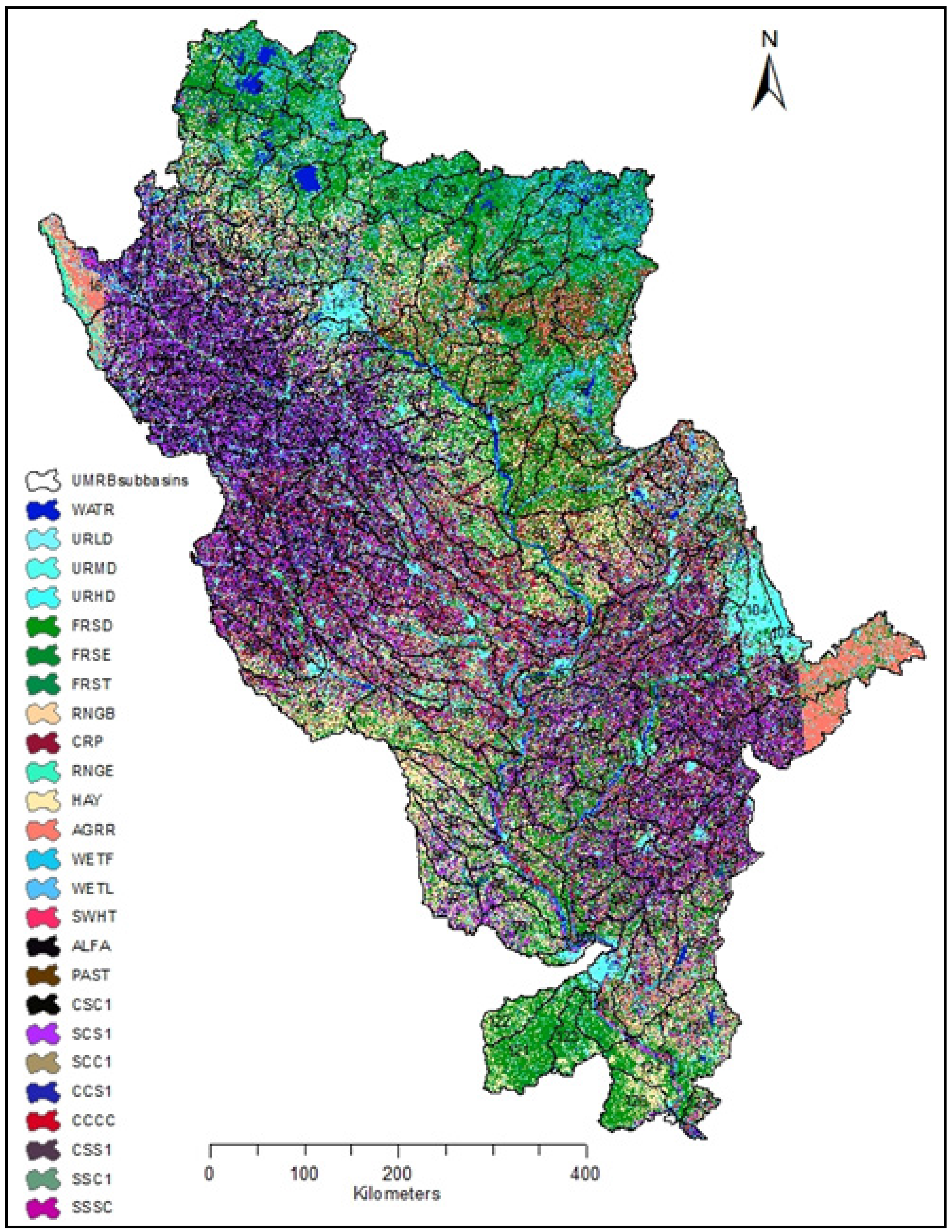
2.4. Scenario Development
| Scenarios | Description | Crop Rotation | Stover Harvest Rate (%) | Management Practices | Cropland Replaced with Switchgrass (%) |
|---|---|---|---|---|---|
| Baseline | Corn-Soybean | 0 | Conventional Till | 0 | |
| (A) Changes in Landuse or Cropping Conditions | |||||
| A1 | (i) Yield Comparison | Regular Continuous Corn | 0 | 0 | |
| A2 | High yielding Continuous Corn | 0 | 0 | ||
| A3 | (ii) Landuse Change for Biofuel Expansion | Corn-Soybean | 0 | 25 | |
| A4 | Corn-Soybean | 0 | 50 | ||
| A5 | Corn-Soybean | 0 | 75 | ||
| A6 | Corn-Soybean | 0 | 100 | ||
| (B) Changes in Management Practices | |||||
| B1 | (i) Residue Removal Rates | Continuous Corn | 25 | 0 | |
| B2 | Continuous Corn | 50 | 0 | ||
| B3 | Continuous Corn | 75 | 0 | ||
| B4 | (ii) Sustainable corn-soybean management | Continuous Corn | 0 | No-Till | 0 |
| B5 | Continuous Corn | 25 | No-Till | 0 | |
| B6 | Continuous Corn | 50 | No-Till | 0 | |
| B7 | Continuous Corn | 75 | No-Till | 0 | |
| (C) Climate Variability | |||||
| C1 | Precipitation increased by 10% | Corn-Soybean | 0 | 0 | |
| C2 | Temperature increased by 2 °C and precipitation decreased by 10% | Corn-Soybean | 0 | 0 | |
- (a)
- Changes in landuse or cropping conditions
- (i)
- Yield intensification: Changes in cropping conditions were simulated by a scenario with continuous corn plantation (A1) and a yield intensification scenario (A2) in which all the area within the basin having corn-soybean (approximately 125,000 sq. km) rotation under the baseline scenario was simulated as continuous corn of regular variety and a high yielding variety respectively.
- (ii)
- Landuse change for biofuel expansion: Changes in landuse was simulated by scenarios (A3, A4, A5, A6) depicting gradual spatial conversion of the current cropland to dedicated energy grasses such as switchgrass. The replacement of cropland with switchgrass ranged from 25% to 100% and helped to identify the point where the replacement will have significant impact and thereby helped to determine an optimal land allocation that maximizes net returns with minimal environmental impacts.
- (b)
- Changes in management practices
- (i)
- Residue removal rates: Corn stover is being considered as an attractive sources of biomass in a way that agricultural residue is utilized while the harvested grain is still used for feed. More than 90% of the corn stover in the US is left on the fields; about 5% is baled for animal feed and bedding, and less than 1% is used for industrial processing [38]. This amounts to 100–150 million tons of corn stover, in the Midwest alone, left on fields for erosion control and nutrient/carbon build-up in the soils [39]. The benefits of corn stover removal are: (1) higher ethanol production rate per unit arable land; (2) energy recovery from lignin-rich fermentation residues; (3) less competition for food and feed; (4) lower nitrogen related environmental burdens from the soil such as decreased N2O from the soil, reduced inorganic nitrogen losses due to leaching. The disadvantages of corn stover removal are: (1) a lower replenishment rate of soil organic carbon; (2) higher soil erosion rates due to the lack of ground cover; (3) higher fuel consumption in harvesting corn stover unless technology is improved to harvest both grain and stover in a single pass [38]. Under this scenario, we ran simulations (B1, B2, B3) with different corn stover removal rates ranging from 25% to 75% under baseline tillage conditions with no cover crops.
- (ii)
- Sustainable corn-soybean management: Sustainable reduced tillage production systems sometimes help to reduce the adverse effects of removal of agricultural residues. Powers et al. [40] found that even with 75% removal of corn stover, practicing no-till system produced 3% less erosion compared to corn-soybean conventional tillage system. Therefore we simulated scenarios (B4, B5, B6, B7) resulting from different percentages of corn stover removal (25%–75%) under no-till conditions with no cover crops.
- (c)
- Climate variability
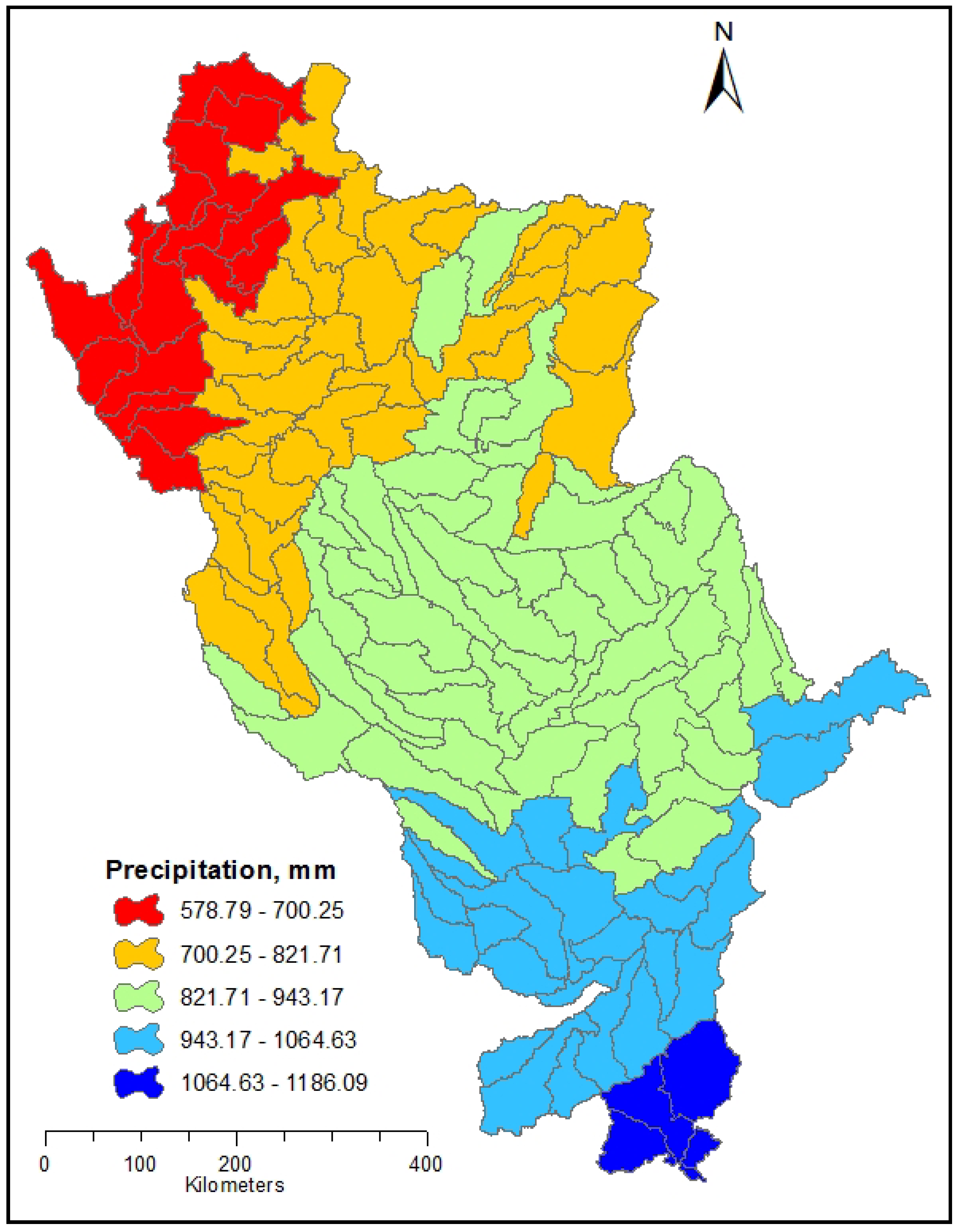
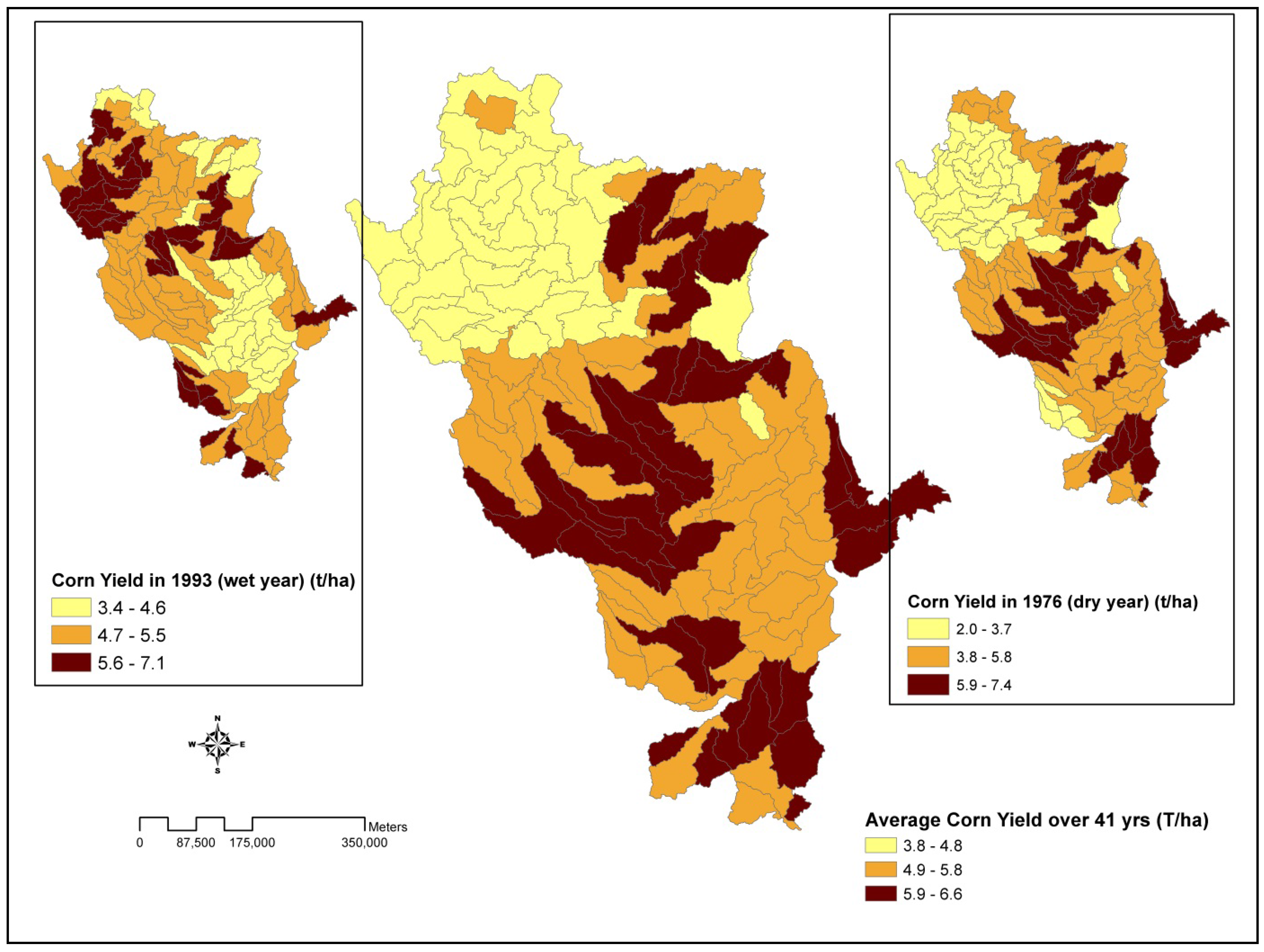
| Year | Precipitation (mm) | ET (mm) | Water Yield (mm) | Surface Water Yield (mm) | Groundwater Yield (mm) | |||||
|---|---|---|---|---|---|---|---|---|---|---|
| Average | % Change over Baseline | Average | % Change over Baseline | Average | % Change over Baseline | Average | % Change over Baseline | Average | % Change over Baseline | |
| Baseline | 850.1 | 0 | 617.7 | 0 | 200.00 | 0 | 105.0 | 0 | 95.0 | 0 |
| Wet year (1993) | 1100.0 | 29.4 | 605.2 | −2.0 | 502.7 | 151.4 | 311.9 | 197.1 | 190.8 | 100.9 |
| Dry year (1976) | 569.1 | −33.06 | 546.0 | −11.6 | 143.8 | −28.1 | 48.3 | −54.0 | 95.5 | 0.6 |
3. Results and Discussion
| Scenarios | % Change from Baseline | ||||||
|---|---|---|---|---|---|---|---|
| Precipitation | ET | Water Yield | Surface Water Yield | Groundwater Yield | Sediment Load | Total Nitrogen Load | |
| Baseline | 0 | 0 | 0 | 0 | 0 | 0 | 0 |
| A1 | 0 | 0.2 | −0.5 | 0 | −1 | 1.6 | −1.5 |
| A2 | 0 | 0.2 | −0.5 | 0 | −1 | 1.6 | −1.5 |
| A3 | 0 | 0.7 | −1.4 | 0 | −2.9 | 7.6 | −10.1 |
| A4 | 0 | −5.2 | 9.4 | −0.8 | 20.6 | −96.1 | −69 |
| A5 | 0 | −5.2 | 9.4 | −0.8 | 20.6 | −96.1 | −69 |
| A6 | 0 | −4.8 | 10.2 | −0.1 | 21.6 | −95.6 | −70.4 |
| B1 | 0 | 2.8 | −6.4 | 0 | −13.5 | −3.1 | −9.1 |
| B2 | 0 | 3.7 | −8.2 | 0 | −17.3 | 5.9 | −13.5 |
| B3 | 0 | 4.4 | −9.8 | 0 | −20.6 | 26.5 | −5.6 |
| B4 | 0 | −0.2 | 0.4 | 0 | 0.9 | −2.6 | −2.1 |
| B5 | 0 | 2.6 | −6 | 0 | −12.5 | −5.5 | −12.5 |
| B6 | 0 | 3.5 | −6 | 0 | −16.6 | 3.2 | −12.5 |
| B7 | 0 | 3.5 | −7.9 | 0 | −16.6 | 3.2 | −19.6 |
| C1 | −10 | −2.1 | −31.9 | −41.2 | −21.5 | −42.3 | −37.5 |
| C2 | −10 | 1.2 | −41.6 | −57.1 | −24.6 | −50.3 | −48.4 |
3.1. Impacts on Water Yield and Water Consumption

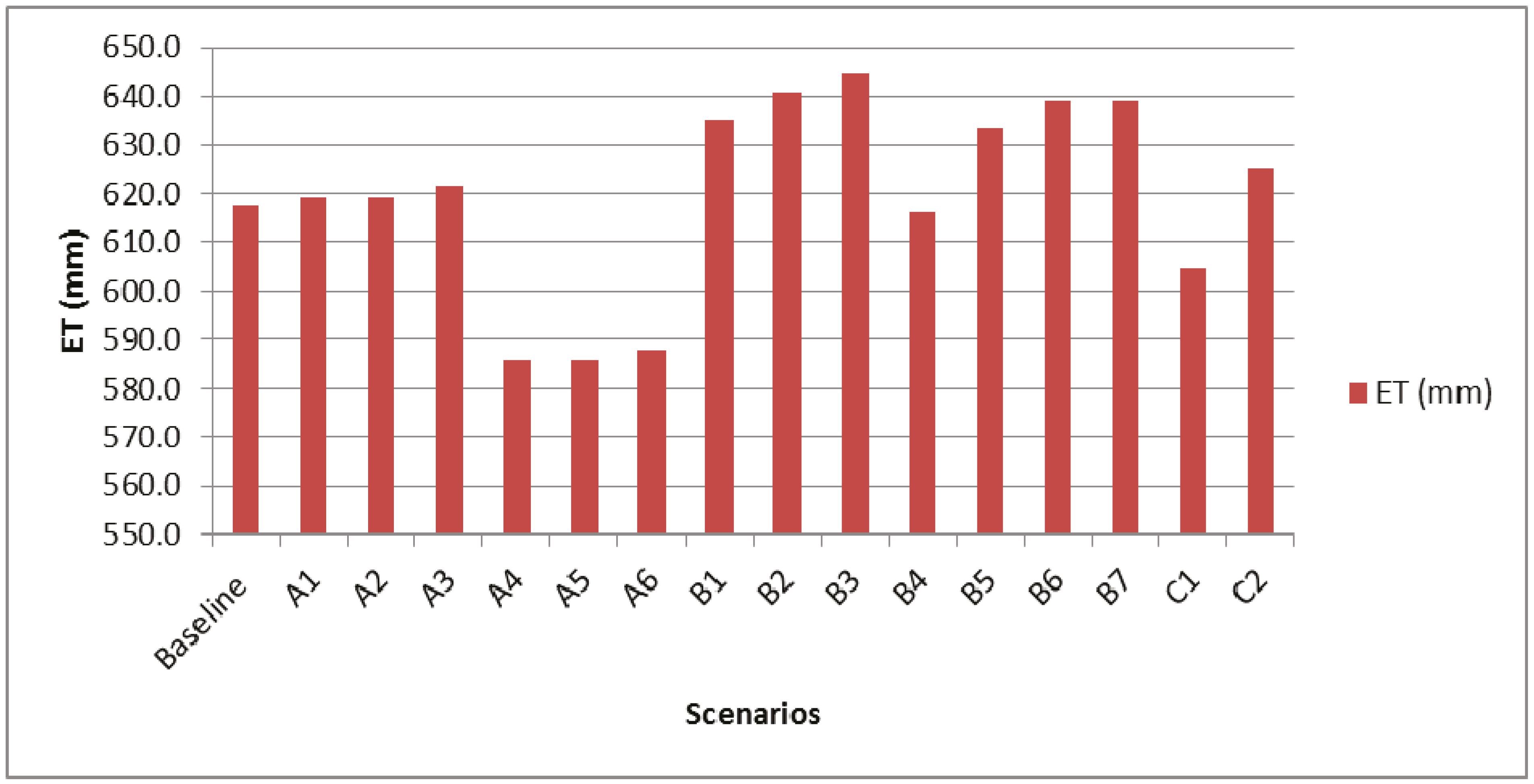
3.2. Impacts on Soil Erosion and Sediment Control
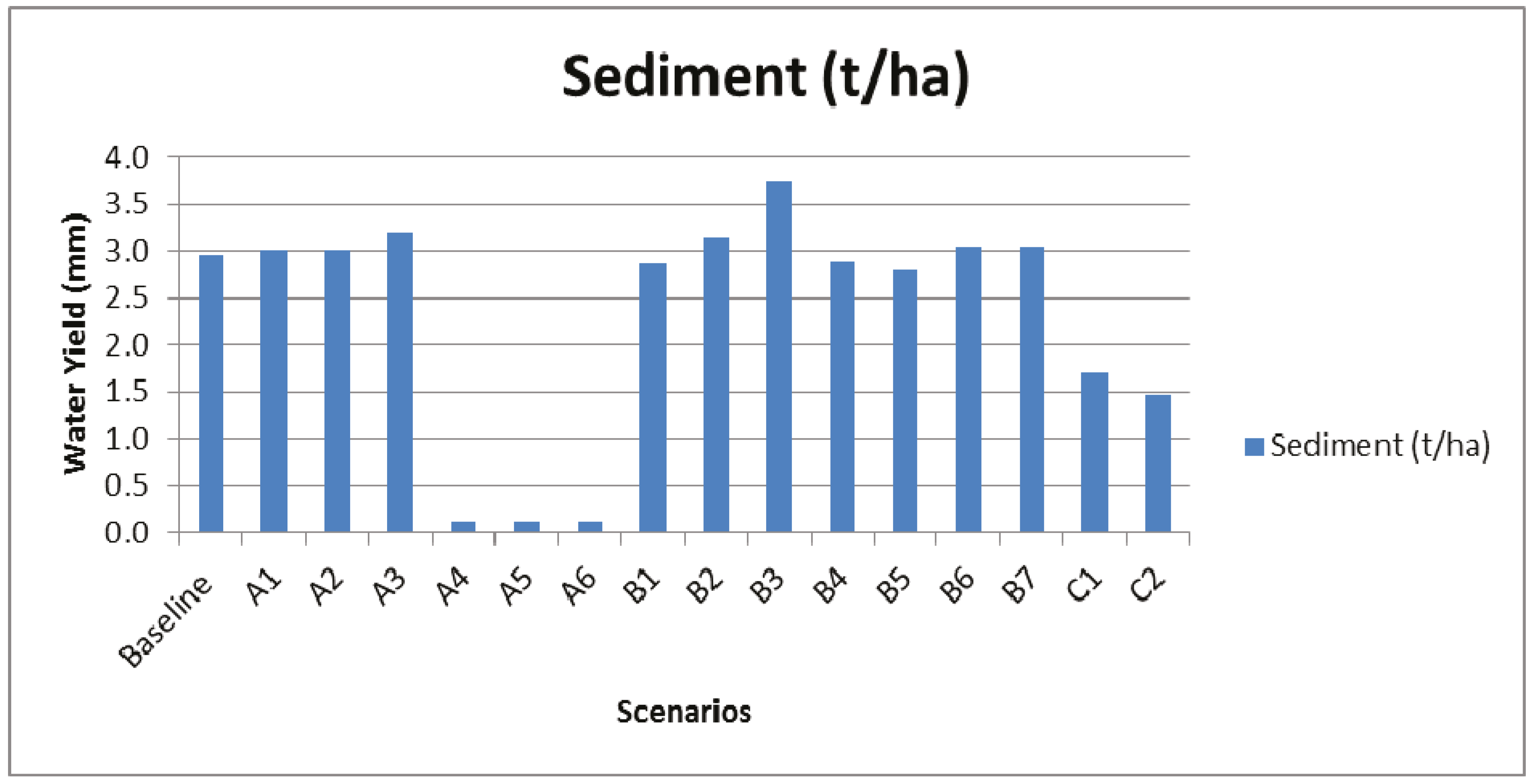
3.3. Impacts on Nutrient Loads
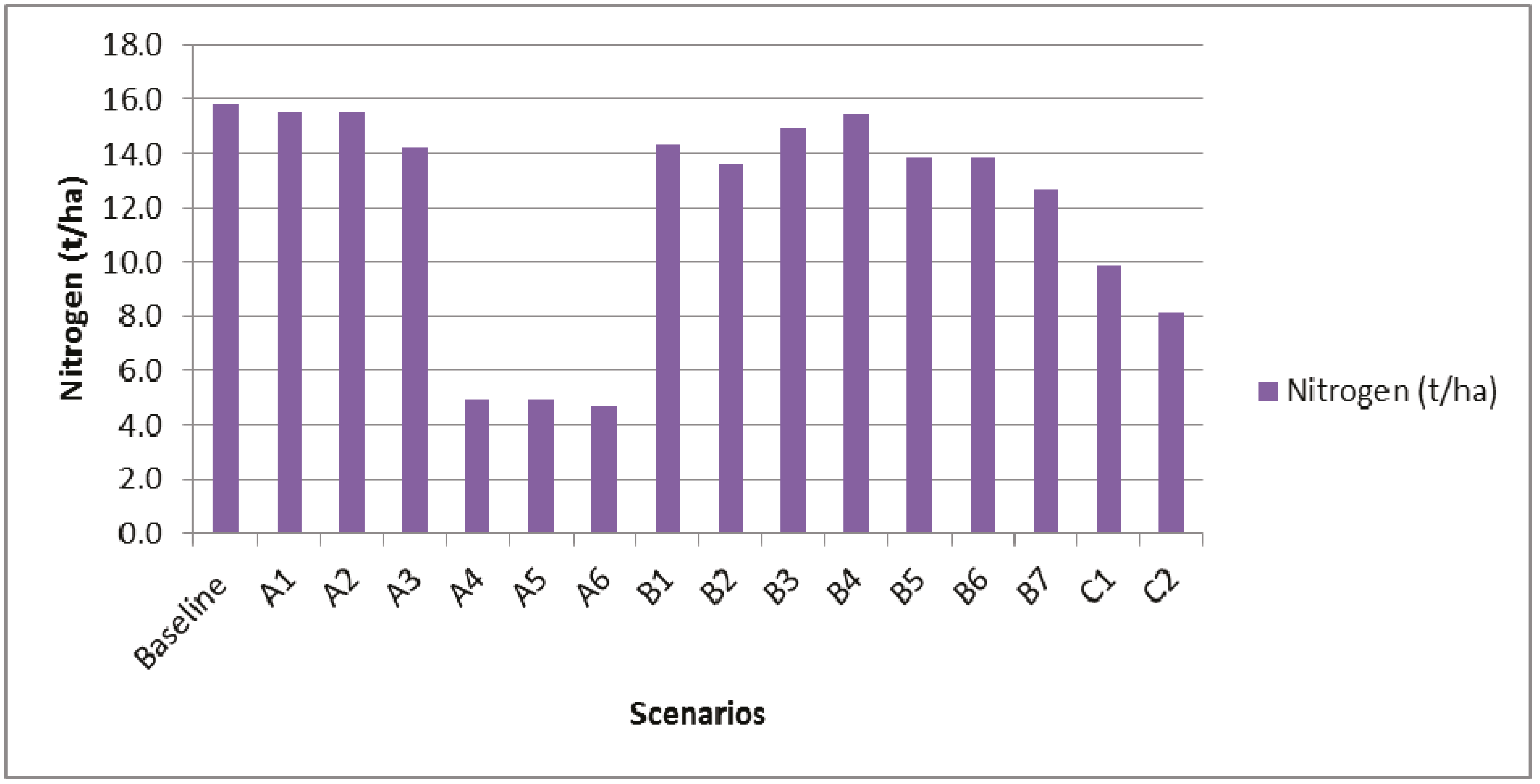
3.4. Spatial Impacts of Biofuel Production
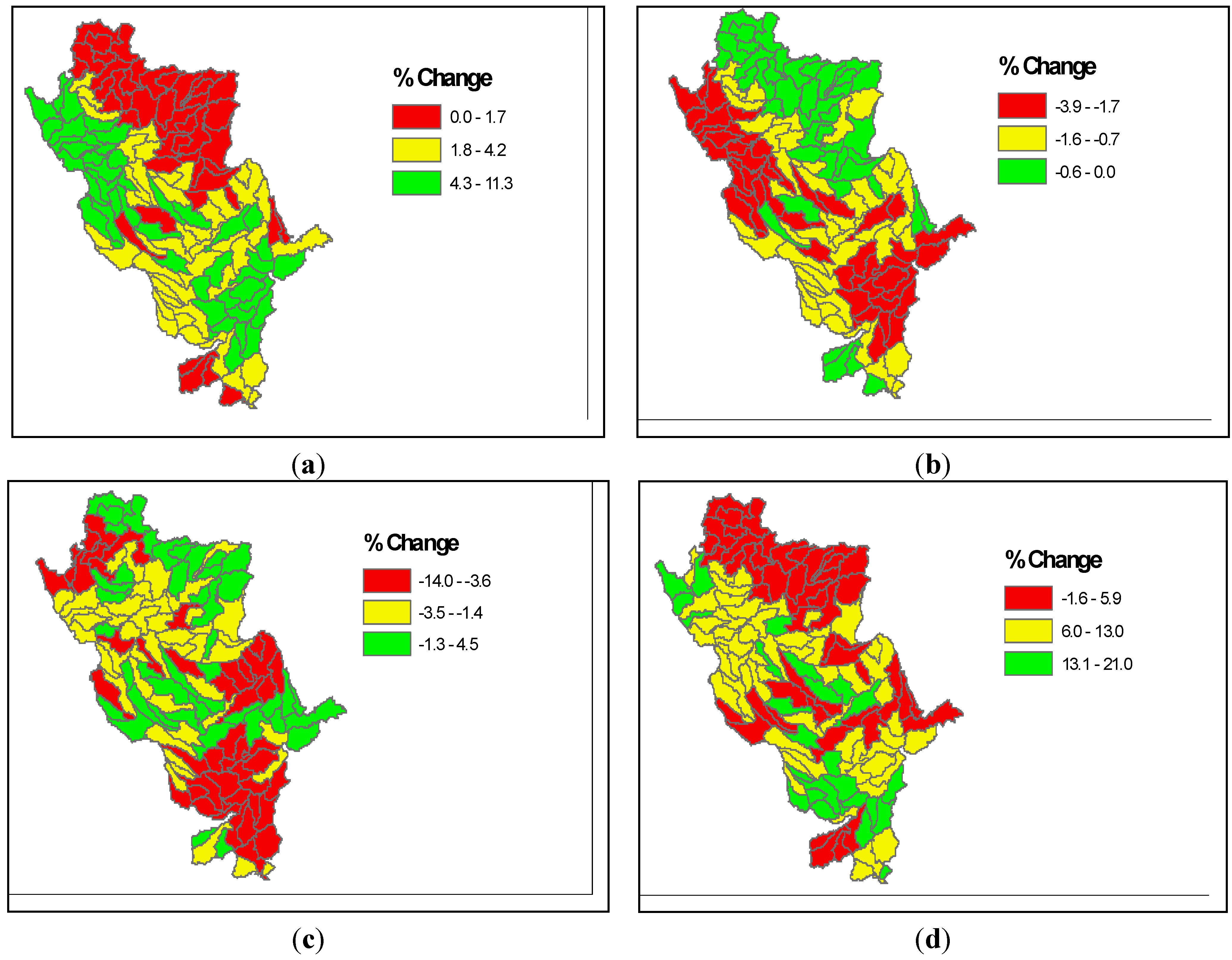
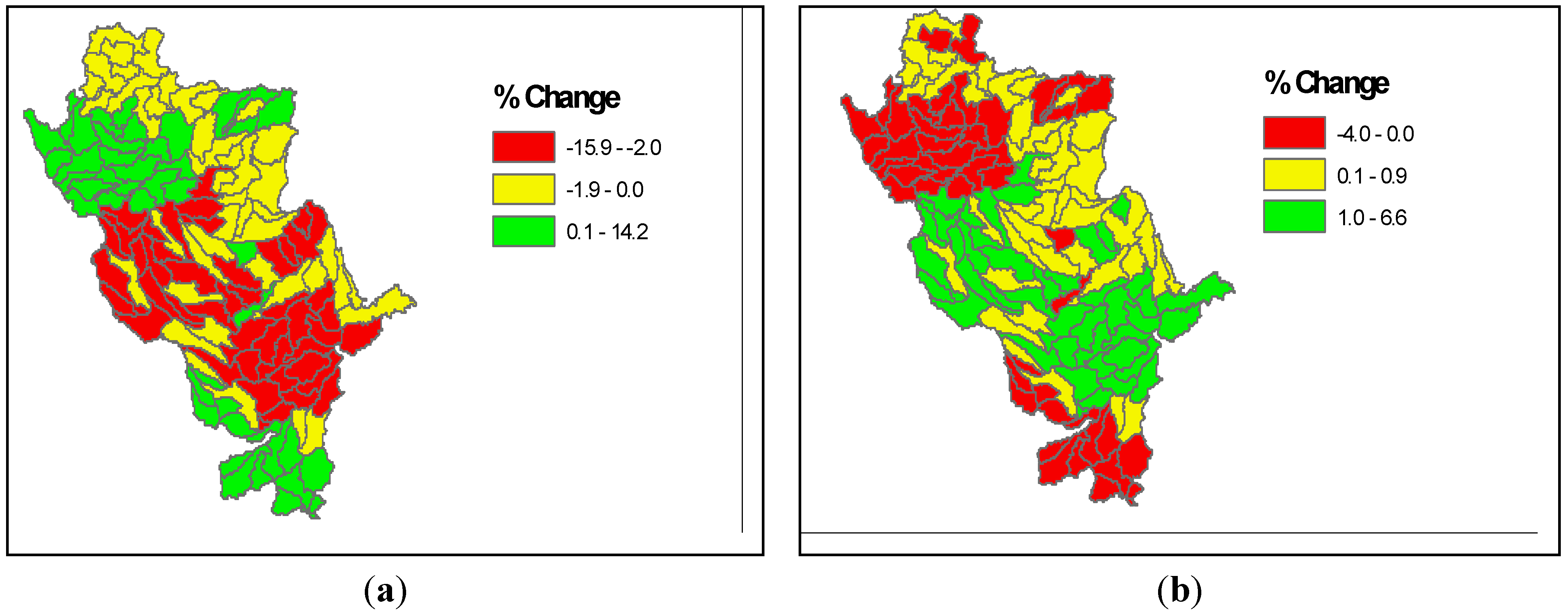
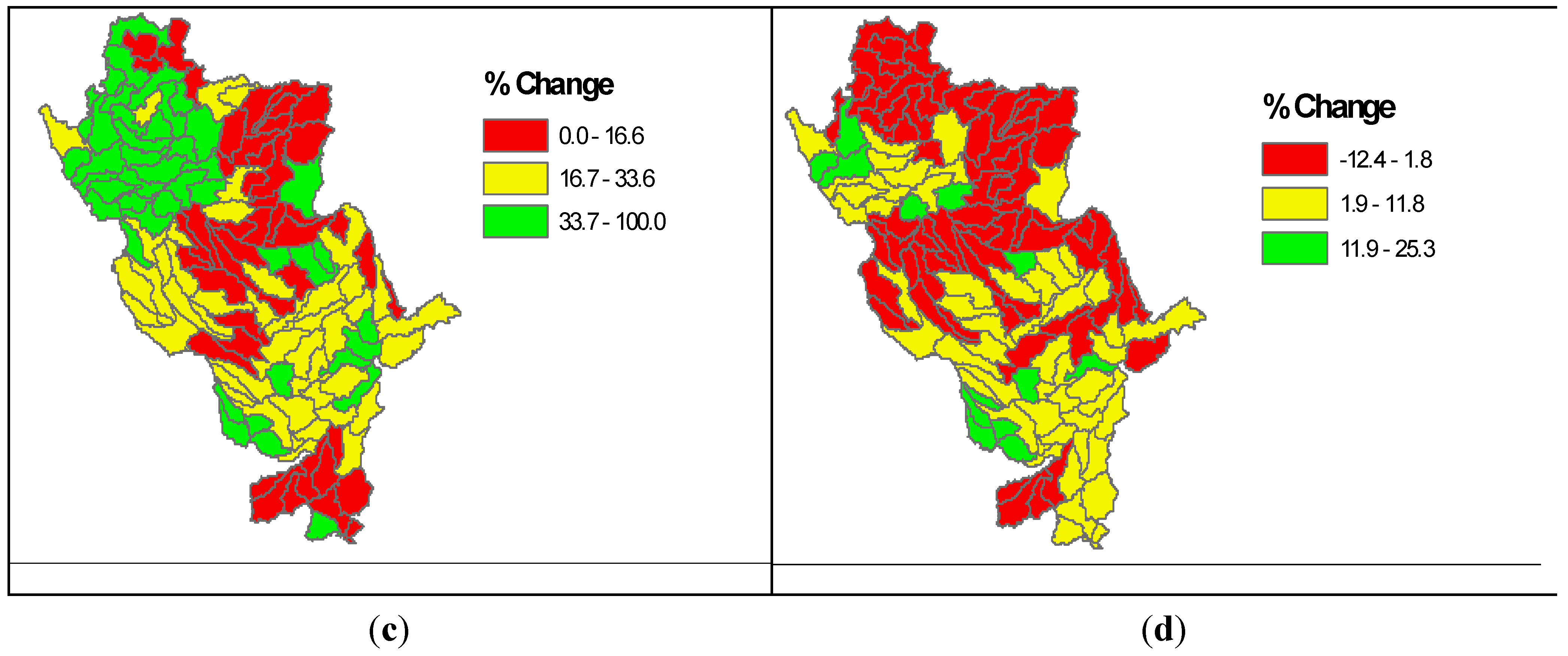

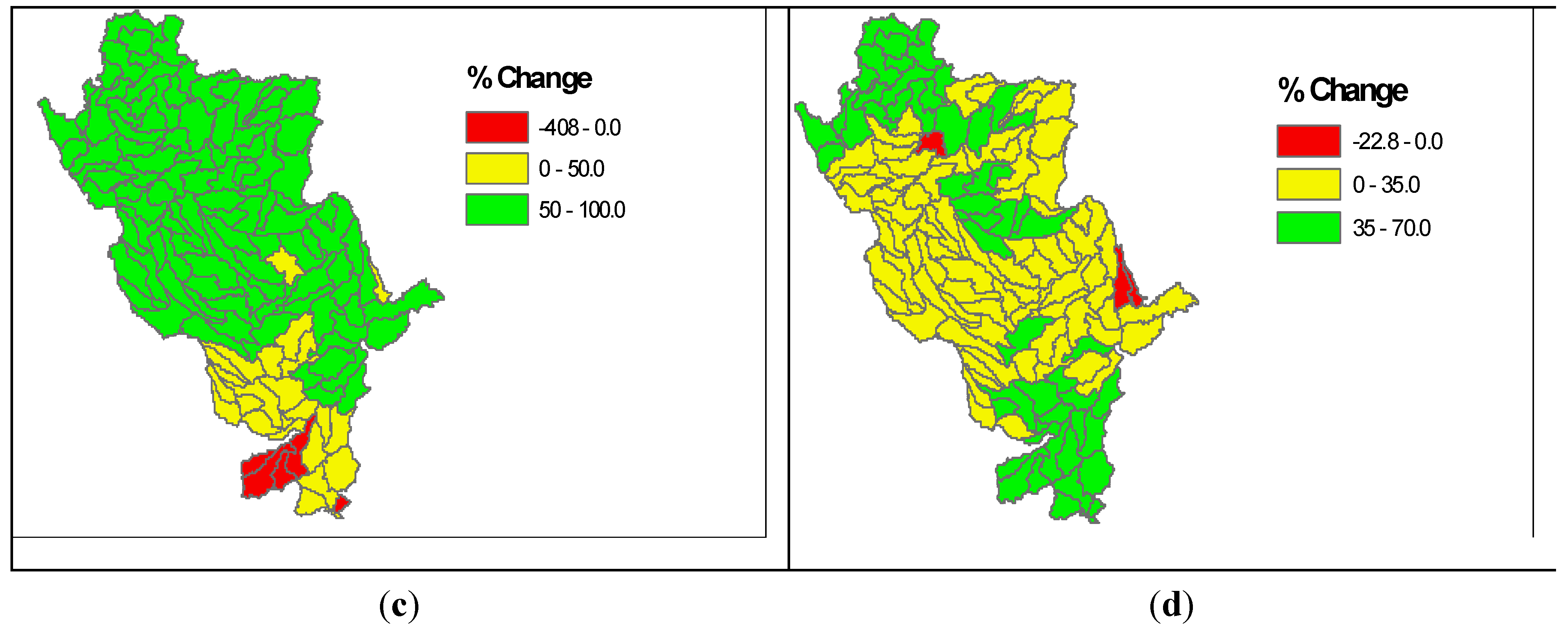
4. Summary and Conclusions
Acknowledgments
Author Contributions
Conflicts of Interest
References
- National Greenhouse Gas Emissions Data. Available online: http://www.epa.gov/climatechange/ghgemissions/usinventoryreport.html (accessed on 5 June 2015).
- Fraiture, C.; Giordano, D.M.; Liao, Y. Biofuels and implications for agricultural water use: Blue impacts of green energy. Water Policy 2008, 10, 67–81. [Google Scholar] [CrossRef]
- Solomon, S.; Qin, D.; Manning, M.; Chen, Z.; Marquis, M.; Averyt, K.B.; Tignor, M.; Miller, H.L. Climate Change 2007: The Physical Science Basis; Contribution of Working Group I to the Fourth Assessment Report of the Intergovernmental Panel on Climate Change; Cambridge University Press: Cambridge, UK, 2007. [Google Scholar]
- Fargione, J.; Hill, J.; Tilman, D.; Polasky, S.; Hawthorne, P. Land clearing and the biofuel carbon debt. Science 2008, 319, 1235–1238. [Google Scholar] [CrossRef] [PubMed]
- Secchi, S.; Gassman, P.W.; Jha, M.; Kurkalova, L.; Kling, C.L. Potential water quality changes due to corn expansion in the Upper Mississippi River Basin. Ecol. Appl. 2011, 21, 1068–1084. [Google Scholar] [CrossRef] [PubMed]
- Heaton, E.A.; Dohleman, F.G.; Long, S.P. Meeting US biofuel goals with less land: The potential of Miscanthus. Glob. Chang. Biol. 2008, 14, 2000–2014. [Google Scholar] [CrossRef]
- Christensen, J.H.; Hewitson, B.; Busuioc, A.; Chen, A.; Gao, X.; Held, R.; Jones, R.; Kolli, R.K.; Kwon, W.K.; Laprise, R.; et al. Regional Climate Projections, Climate Change, 2007: The Physical Science Basis; Contribution of Working group I to the Fourth Assessment Report of the Intergovernmental Panel on Climate Change; University Press: Cambridge, UK, 2007; Chapter 11. [Google Scholar]
- Karl, T.R.; Melillo, J.M. Global Climate Change Impacts in the United States; Cambridge University Press: Cambridge, UK, 2009. [Google Scholar]
- Rabalais, N.N.; Turner, R.E.; Wiseman, W.J. Gulf of Mexico, aka the dead zone. Annu. Rev. Ecol. Syst. 2002, 33, 235–263. [Google Scholar] [CrossRef]
- Dale, V.H.; Kline, K.L.; Wiens, J.; Fargione, J. Biofuels: Implications for Land Use and Biodiversity; Ecological Society of America: Washington, DC, USA, 2010. [Google Scholar]
- Searchinger, T.; Heimlich, R.; Houghton, R.A.; Dong, F.; Elobeid, A.; Fabiosa, J.; Tokgoz, S.; Hayes, D.; Yu, T.H. Use of US croplands for biofuels increases greenhouse gases through emissions from land-use change. Science 2008, 319, 1238–1240. [Google Scholar] [CrossRef] [PubMed]
- Dominguez-Faus, R.; Powers, S.E.; Burken, J.G.; Alvarez, P.J. The water footprint of biofuels: A drink or drive issue? Environ. Sci. Technol. 2009, 43, 3005–3010. [Google Scholar] [CrossRef] [PubMed]
- Gerbens-Leenes, P.W.; Hoekstra, A.Y.; van der Meer, T.H. The water footprint of energy from biomass: A quantitative assessment and consequences of an increasing share of bio-energy in energy supply. Ecol. Econ. 2009, 68, 1052–1060. [Google Scholar] [CrossRef]
- Thomas, M.A.; Engel, B.A.; Chaubey, I. Water quality impacts of corn production to meet biofuel demands. J. Environ. Eng. 2009, 135, 1123–1135. [Google Scholar] [CrossRef]
- Love, B.J.; Nejadhashemi, A.P. Water quality impact assessment of large-scale biofuel crops expansion in agricultural regions of Michigan. Biomass Bioenergy 2011, 35, 2200–2216. [Google Scholar] [CrossRef]
- De la Torre Ugarte, D.G.; He, L.; Jensen, K.L.; English, B.C. Expanded ethanol production: Implications for agriculture, water demand, and water quality. Biomass Bioenergy 2010, 34, 1586–1596. [Google Scholar] [CrossRef]
- Wu, M.; Demissie, Y.; Yan, E. Simulated impact of future biofuel production on water quality and water cycle dynamics in the Upper Mississippi river basin. Biomass Bioenergy 2012, 41, 44–56. [Google Scholar] [CrossRef]
- Wu, Y.; Liu, S. Impacts of biofuels production alternatives on water quantity and quality in the Iowa River Basin. Biomass Bioenergy 2012, 36, 182–191. [Google Scholar] [CrossRef]
- Wu, Y.; Liu, S.; Li, Z. Identifying potential areas for biofuel production and evaluating the environmental effects: A case study of the James River Basin in the Midwestern United States. GCB Bioenergy 2012, 4, 875–888. [Google Scholar] [CrossRef]
- Ng, T.L.; Eheart, J.W.; Cai, X.; Miguez, F. Modeling Miscanthus in the soil and water assessment tool (SWAT) to simulate its water quality effects as a bioenergy crop. Environ. Sci. Technol. 2010, 44, 7138–7144. [Google Scholar] [CrossRef] [PubMed]
- Evans, J.M.; Cohen, M.J. Regional water resource implications of bioethanol production in the southeastern United States. Glob. Change Biol. 2009, 15, 2261–2273. [Google Scholar] [CrossRef]
- Zhuang, Q.; Qin, Z.; Chen, M. Biofuel, land and water: Maize, switchgrass or Miscanthus? Environ. Res. Lett. 2013, 8. [Google Scholar] [CrossRef]
- VanLoocke, A.T.; Twine, E.; Zeri, M.; Bernacchi, C.J. A regional comparison of water use efficiency for miscanthus, switchgrass and maize. Agric. For. Meteorol. 2012, 164, 82–95. [Google Scholar] [CrossRef]
- Demissie, Y.; Yan, E.; Wu, M. Assessing regional hydrology and water quality implications of large-scale biofuel feedstock production in the Upper Mississippi river basin. Environ. Sci. Technol. 2012, 46, 9174–9182. [Google Scholar] [CrossRef] [PubMed]
- Brown, R.A.; Rosenberg, N.J.; Hays, C.J.; Easterling, W.E.; Mearns, L.O. Potential production and environmental effects of switchgrass and traditional crops under current and greenhouse-altered climate in the central United States: A simulation study. Agric. Ecosyst. Environ. 2000, 78, 31–47. [Google Scholar] [CrossRef]
- Tulbure, M.G.; Wimberly, M.C.; Boe, A.; Owens, V.N. Climatic and genetic controls of yields of switchgrass, a model bioenergy species. Agric. Ecosyst. Environ. 2012, 146, 121–129. [Google Scholar] [CrossRef]
- Upper Mississippi River Basin Association. Available online: www.umrba.org/facts.htm (accessed on 5 June 2015).
- Jha, M.; Pan, Z.; Takle, E.S.; Gu, R. Impacts of climate change on streamflow in the Upper Mississippi River Basin: A regional climate model perspective. J. Geophys. Res.: Atmos. 2004, 109, 1984–2012. [Google Scholar]
- Assessment of the Effects of Conservation Practices on Cultivated Cropland. Available online: http://www.nasda.org/File.aspx?id=4382 (accessed on 5 June 2015).
- Watershed Modeling of Potential Impacts of Biofuel Feedstock Production in the Upper Mississippi River Basin. Available online: http://www.ipd.anl.gov/anlpubs/2012/08/73898.pdf (accessed on 5 June 2015).
- Arnold, J.G.; Srinivasan, R.; Muttiah, R.S.; Allen, P.M. Continental scale simulation of the hydrologic balance. J. Am. Water Resour. Assoc. 1999, 35, 1037–1051. [Google Scholar] [CrossRef]
- Gassman, P.W.; Reyes, M.R.; Green, C.H.; Arnold, J.G. The soil and water assessment tool: Historical development, applications and future research directions. Trans. ASABE 2007, 50, 1211–1250. [Google Scholar] [CrossRef]
- U.S. Department of Agriculture, National Agriculture Statistics Service. Available online: http://www.nass.usda.gov/research/Cropland/SARS1a.htm (accessed on 5 June 2015).
- Homer, C.; Huang, C.; Yang, L.; Wylie, B.; Coan, M. Development of a 2001 national land-cover database for the United States. Photogramm. Eng. Remote Sens. 2004, 70, 829–840. [Google Scholar] [CrossRef]
- Conservation Technology Information Centre. Available online: http://www.ctic.purdue.edu/ (accessed on 5 June 2015).
- Di Luzio, M.; Johnson, G.L.; Daly, C.; Eischeid, J.K.; Arnold, J.G. Constructing retrospective gridded daily precipitation and temperature datasets for the conterminous United States. J. Appl. Meteorol. Climatol. 2008, 47, 475–497. [Google Scholar] [CrossRef]
- Srinivasan, R.; Zhang, X.; Arnold, J. SWAT ungauged: Hydrological budget and crop yield predictions in the Upper Mississippi River Basin. Trans. ASABE 2010, 53, 1533–1546. [Google Scholar] [CrossRef]
- Kim, S.; Dale, B.E. Life cycle assessment of various cropping systems utilized for producing biofuels: Bioethanol and Biodiesel. Biomass Bioenergy 2005, 29, 426–439. [Google Scholar] [CrossRef]
- Cellulosic Ethanol from Corn Stover: Calculating and Improving the Bottom Line. Available online: http://www.ars.usda.gov/is/AR/archive/oct08/corn1008.pdf (accessed on 5 June 2015).
- Powers, S.E.; Ascough, J.C.; Nelson, R.G.; Larocque, G.R. Modeling water and soil quality environmental impacts associated with bioenergy crop production and biomass removal in the Midwest USA. Ecol. Model. 2011, 222, 2430–2447. [Google Scholar] [CrossRef]
© 2015 by the authors; licensee MDPI, Basel, Switzerland. This article is an open access article distributed under the terms and conditions of the Creative Commons Attribution license (http://creativecommons.org/licenses/by/4.0/).
Share and Cite
Deb, D.; Tuppad, P.; Daggupati, P.; Srinivasan, R.; Varma, D. Spatio-Temporal Impacts of Biofuel Production and Climate Variability on Water Quantity and Quality in Upper Mississippi River Basin. Water 2015, 7, 3283-3305. https://doi.org/10.3390/w7073283
Deb D, Tuppad P, Daggupati P, Srinivasan R, Varma D. Spatio-Temporal Impacts of Biofuel Production and Climate Variability on Water Quantity and Quality in Upper Mississippi River Basin. Water. 2015; 7(7):3283-3305. https://doi.org/10.3390/w7073283
Chicago/Turabian StyleDeb, Debjani, Pushpa Tuppad, Prasad Daggupati, Raghavan Srinivasan, and Deepa Varma. 2015. "Spatio-Temporal Impacts of Biofuel Production and Climate Variability on Water Quantity and Quality in Upper Mississippi River Basin" Water 7, no. 7: 3283-3305. https://doi.org/10.3390/w7073283







